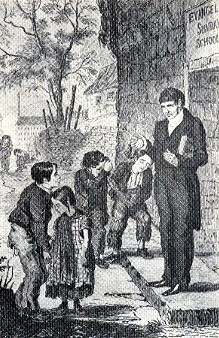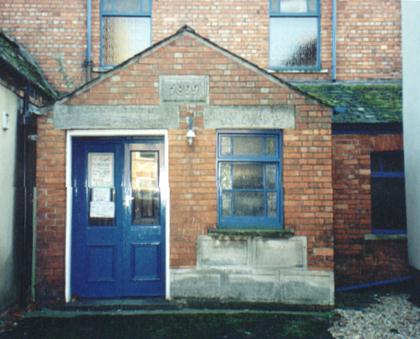|
Sunday Schools
A Sunday School is the place where religious instruction is given to children and young people on Sundays, the classes being held either in a church or chapel or in specially built classrooms. They are less popular today than in previous centuries when most children attended at least once on a Sunday although many of the stricter sects held both morning and afternoon sessions.
The catechising of the young was adopted by the Christians from Judaic practice although the application has fluctuated in scope at different periods and places. In 18th century England, specific instruction of children by the clergy was generally rare and limited and the majority of children from the poorest classes never attended a place of worship. The first Sunday School is believed to have been that at High Wycombe in Buckinghamshire founded by Hannah Ball in 1769 and five years later, a dissenter organised another at Nailsworth in Gloucestershire and so established the tradition among the non-conformist religions that remains with us to this day.
| The main impulse towards the foundation of the English Sunday School movement however came from Robert Raikes
(1735-1811), publisher and philanthropist, who was instrumental in
founding one of the first Sunday Schools for children in Sooty Alley,
Gloucester, (opposite the city prison) in 1780 where the poorest children
were taught the scriptures as well as reading and writing, and most of his
pupils were the children of chimney sweeps.
The idea flourished and schools spread with
astonishing rapidity and in 1785 an un-denominational national
organisation, the Sunday School Society, was set up to co-ordinate and
develop the work. By 1784, there were reputed to be 1,800 pupils in
Manchester and Salford with a similar number in Leeds.
But the idea was not without its critics who
complained that it broke the Sabbath and others that it educated the poor
above their station and might even inculcate revolutionary doctrines in
the wake of the French Revolution.
|

A Sunday School in 1840 from The Life and Adventures of
Michael Armstrong by Frances Trollope |
Such prejudice was largely overcome and in 1803,
the inter-denominational Sunday Schools Union was formed and continued as the
national Sunday Schools Union well into the 20th century.
Sunday Schools were a vital part of community life in Bourne during the 19th and
early 20th centuries and the first to be established in the town was at the
Methodist Chapel in West Street which was soon attracting the attention of
visiting clergymen, such as that on Sunday 9th December 1821 when the Rev G
Douglass arrived from Stamford to see the work of the school. "Several of the
children recited pieces appropriate to the occasion, the execution of which
reflected great credit on the teachers and friends of the school and could not
fail to excite feelings of thankfulness and delight in the hearts of all who
were present", reported the Stamford Mercury the following Friday. "The
chapel was crowded to excess and the contributions were very liberal. Any
institution like this deserves encouragement from all who entertain a desire to
see the rising generation brought from the paths of ignorance and wickedness, to
the knowledge of that God, who by the mouth of the royal preceptor hath said:
'Train up a child in the way he should go, and when he is old he will not depart
from it.'"
By 1888, the Sunday School had 150 scholars and 21 teachers enrolled with both
morning and afternoon sessions while 11 neighbouring villages also had Methodist
Sunday Schools. The appearance of Congregationalism in the town in 1846 and the
subsequent building of the Congregational Church [now the United Reformed
Church] in Eastgate brought an even greater impetus and in 1910, a Sunday School
building was opened adjoining the chapel and designed much on the plan of the
Baptist Sunday School in West Street, with a central hall flanked by numerous
classrooms.
This was the hey day of attendance at both church and Sunday School and the Congregationalists had 150 children on their roll who turned out regularly with their banners for parades and public occasions. One of the most popular of these events was an annual parade through the town, accompanied by the town band and parents, including mothers with babies in their prams, to the Park Field in the Austerby for their traditional fete or Sunday School "treat", as it was known, consisting of sports, games, fancy dress, decorated floats and a picnic.
The history of Dyke village, which is within the parish of Bourne, includes a particular example of individual endeavour in the development of local Sunday Schools. Jane Redmile was born in 1800, the eldest daughter of a local farmer. She was a tireless worker for the Baptist Church in Bourne and despite family circumstances that forced her to care for her younger brothers and sisters, she opened a shop and still found time to walk to Bourne twice every Sunday to attend services. Jane was determined to establish a Sunday School in Dyke at her own cost and in 1843, a building was completed and this continued in service for 27 years but was eventually demolished because it lay on the route of the new Bourne to Sleaford railway line. Then in 1861, she bought a small property for Sunday School meetings that were held until the present Baptist Chapel
was opened in 1878. A schoolroom was later added and this was used for the education of local children until late in the 20th century.
There was also a thriving
Sunday School at Tongue End, a lonely hamlet out in the fens, three miles
south of Bourne, established by teachers from several different
denominations in the town who felt there was a particular need for the
facility in this isolated and impoverished community. The inhabitants here
were mainly farm workers but there was sufficient religious belief to
support the school which was established in 1859 and within a year had an
average attendance of 70 children, meeting in temporary accommodation in a
cottage but contemplating the erection of permanent premises, a wish that
was never fulfilled although classes were moved to the new Methodist
Chapel when it opened in 1864. Evidence of its popularity can be found in
a newspaper report from the Stamford Mercury of Friday 26th July
1867:
The
8th anniversary of the Tongue End Sunday School was commenced on Sunday
the 14th last when two excellent sermons were preached by the Rev Joseph
Staddon of Pinchbeck. On the following Wednesday afternoon, the children,
numbering 140, had their usual treat. At 5 o'clock, there was a public tea
which was partaken of by about 230 persons, followed by a public meeting,
presided over by Mr Thomas Aitken who briefly reviewed the prospects of
the cause at Tongue End. Great good had been already effected and he
sincerely hoped that the beneficial influence which had been brought to
bear upon the neighbourhood would continue. Referring to the building
fund, he said that at the commencement of this anniversary, there remained
a debt upon the chapel of a little less than £40 which it was hoped would
soon be cleared off. Mr W R Wherry read the report, from which it appeared
that the school had been maintained in an efficient state, and that the
library in connection therewith had been increased during the past year by
46 volumes. The meeting also addressed by the Revs Thomas Shaw (Wesleyan),
John Bevan (Indepenent), W Orton (Baptist), J J Irving (Calvinist), George
Burgess (Wesleyan), J Bevan (Free Methodist), Mr Dunnington and Mr T
Sharman.
The cause of the Sunday School
had also been championed by many prominent businessmen in Bourne, notably William Wherry (1841-1951), a staunch non-conformist who held practically all of the offices in connection with the Baptist Chapel in West Street where he was a senior deacon and superintendent of the Sunday School, an active appointment which he held dear until shortly before his death. He was widely known as a preacher throughout the district and addressed many Sunday School gatherings in outlying villages, especially at Tongue End where he felt his presence was particularly needed in view of the
reduced circumstances of many of the inhabitants.
New teaching techniques with the use of pictures, drama and films were being introduced at this time and although there was a move by the trade unions during the 19th century to start secular Sunday Schools for the instruction of adults and children, the term today is confined entirely to those with a strictly religious scope and a World Sunday Schools Association was instituted in 1907. The Sunday School movement remains an important part of our social history. Many Sunday Schools, and chapel and church communities, became crucial working class institutions and centres for mutual aid while others provided a link between the charity schools and regular and universal elementary education.
|

Extract from the Souvenir Programme for the Centenary Celebrations (1846-1946) of the Bourne Congregational Church and Sunday School (now the United Reformed Church), 4th to 15th May 1946:
There is ample evidence that from the earliest times the church took great interest in Sunday School work, the school being formed in 1847, for it is recorded that in 1848, the sum of 20 shillings
(more than £50 at today's values) was allowed to be spent on books for the use of the school. The children were accommodated in private houses and in the church until a schoolroom was built about 85 years
ago (pictured above). There were 320 scholars accommodated in the Old Schoolroom, which was less than half the size of the present school, which was rebuilt and re-opened in January 1900. There are 99 scholars on the roll at present and they attend morning service after Sunday School. The Sunday School scholars are being presented with a testament as a memento of the Centenary. |
|
SUNDAY SCHOOL CONCERTS
The presentation of
regular entertainment was part of the Sunday School year and an
example of what the children had to offer is illustrated by this
report from the Stamford Mercury newspaper on Friday 7th
May 1915:
The annual May-day
festival in connection with the Congregational Sunday School was
held on Saturday and Monday. On Saturday, the May morning
breakfast was held in the schoolroom; upwards of 70 sat down. On
Monday an entertainment was held in the schoolroom. The first
portion consisted of miscellaneous items by Miss Madge Atkin,
Master Frank Maxon, Miss Branston, little Miss Phyllis
Tipler, and a doll drill by twelve little children who had been
trained by Mrs A W Swift, while the other part was taken up with a
presentation of the White Garland by about 40 scholars of
the school, chiefly girls, who came on stage to the strains of the
opening chorus Happy Hearts. The principal character (the
Queen) was admirably impersonated by Miss Hilda Hemsell and other
prominent performers were Master Robert Kettle, Master Leslie Law,
Master E Parker, Miss B Mancrief, Miss A Noon and Miss A Sones.
There was a large attendance and the school will benefit by the
undertaking. |
See also
Jane Redmile Feasts and Treats
The Congregational School treat of 1912

Go to:
Main Index Villages
Index
|

